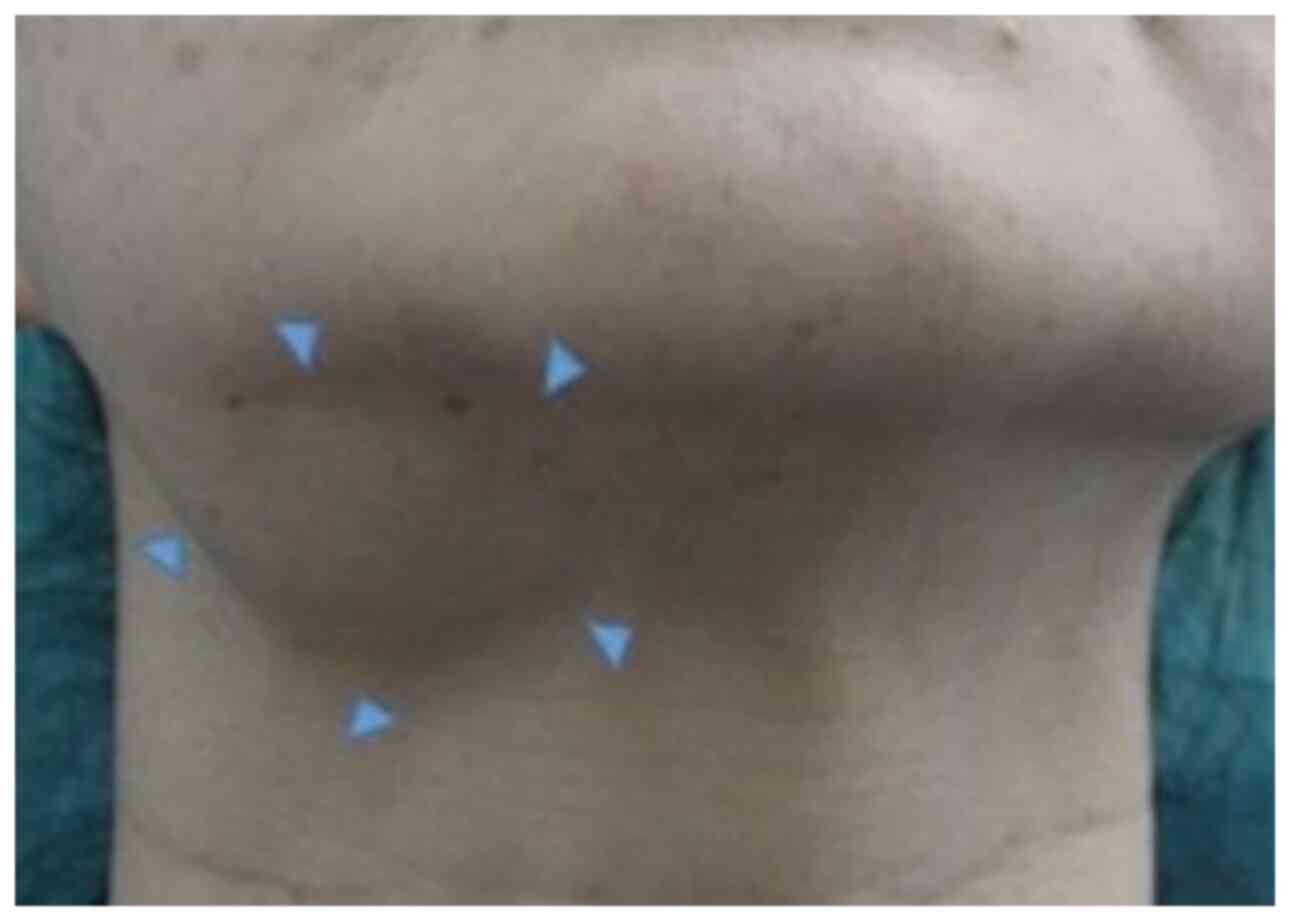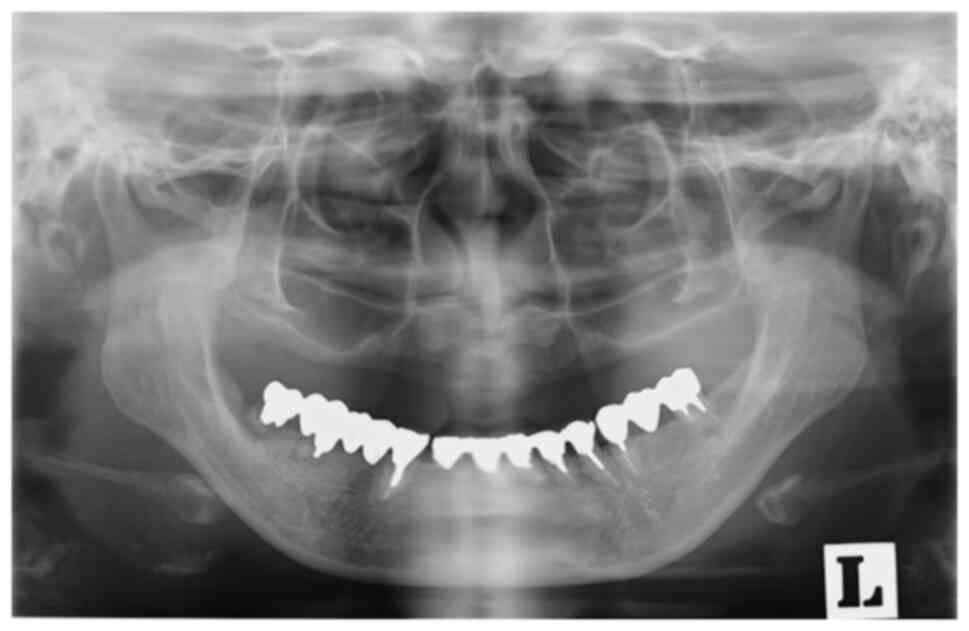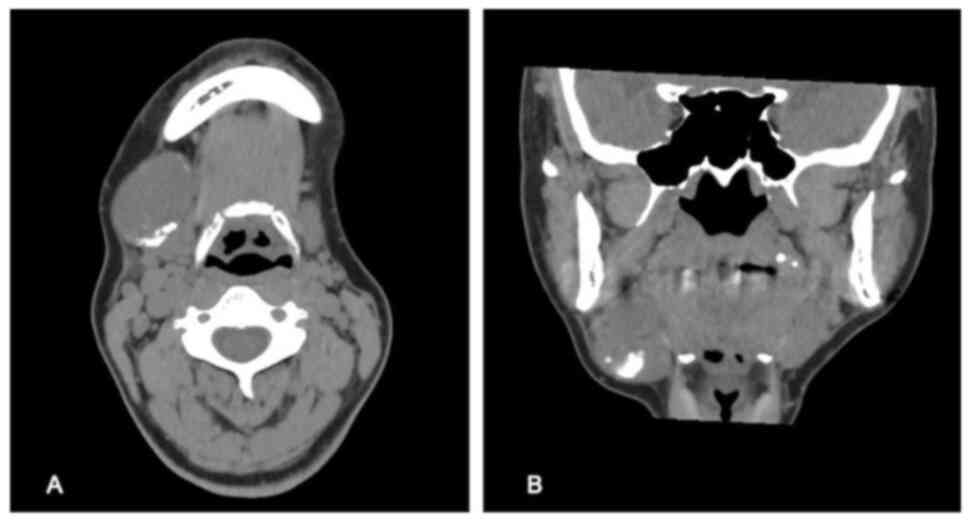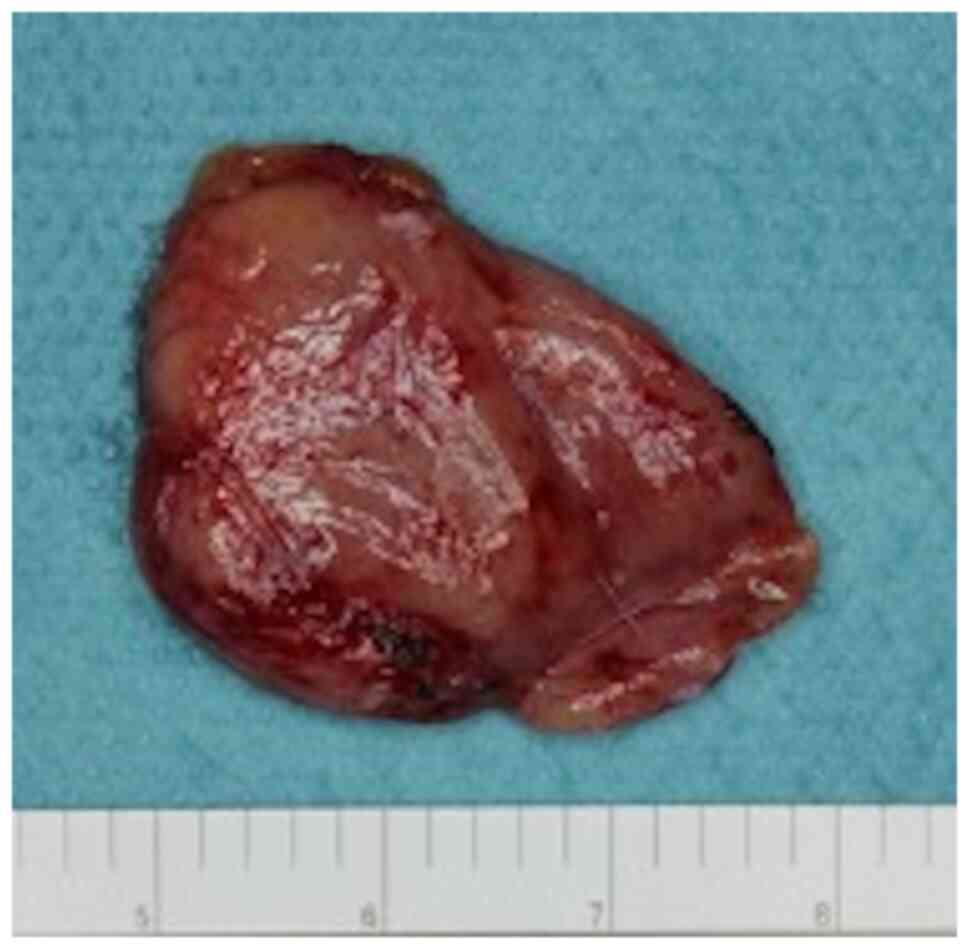A rare case of a branchial cyst with calcification: A case report
- Authors:
- Published online on: June 14, 2023 https://doi.org/10.3892/etm.2023.12065
- Article Number: 366
Abstract
Introduction
Branchial cysts are relatively uncommon lesions, accounting for approximately 1% of neck masses (1). Since Ascherson's report (2) in 1832 that branchial cysts are caused by the remnants of branchiogenic organs, there have been ongoing debates regarding the etiology. There are two major theories regarding the etiology of branchial cysts: the branchial arch-derived theory, wherein the cysts are thought to arise from remnants of embryonic branchial organs (3), and the glandular epithelial theory, wherein the glandular epithelium that has strayed into the lymphoid tissue may have become cystic (4). Nonetheless, there is still no established theory. Histopathologically, a branchial cyst typically presents as a cyst wall covered with squamous epithelium, lymphoid tissue, and lymphoid follicles with germinal centers found under the epithelium (4), and complete surgical resection is the first-line treatment for branchial cysts (5).
Branchial cysts often occur above the neck at the anterior margin of the sternocleidomastoid muscle (5), but there have also been reports of cysts in the oral cavity, including in the tongue, oral floor, soft palate, buccal mucosa (6), and parotid gland (7). Onset has been reported in both the young and old (8-11), with the most common age reported to be in the 20-30s (8-10,12). Some reports indicate that there is no gender difference (13), but branchial cysts are slightly more common in women (8-12). Furthermore, while some reports indicate that there is no difference in incidence between left and right sides of the body (9,10), other reports indicate that it is more common on the left side (12). Branchial cysts are not a progressive disease, but in most cases, they cause cosmetic problems and recurrent infections and do not spontaneously remit, thus requiring treatment (14,15). Although rare, squamous cell carcinoma may arise from the epithelium of this cyst (16).
Although there are numerous reports of branchial cysts in literature, to the best of our knowledge, there have been no reports of calcification in the cystic cavity of branchial cysts. We believe that the presence of calcification in branchial cysts is an extremely rare occurrence. Therefore, herein, we describe a unique case of branchial cyst of the submandibular region with calcification, along with a review of the literature on the factors contributing to calcification.
Case report
A 49-year-old woman presented to our department with a complaint of swelling in the right submandibular region. The patient initially became aware of a mass in the same location 9 years prior but opted out of active treatment and was instead placed under observation. However, the swelling had increased several months before the first visit to our department, prompting a thorough examination.
The patient's medical and family history was unremarkable. Upon physical examination, an elastic and soft cyst with no tenderness measuring 24x37 mm that was clearly demarcated from the surroundings was found in the right submandibular region (Fig. 1). A panoramic radiograph further revealed a cystic lesion with a well-circumscribed border in the same region and a crescent-shaped radiopaque finding in the base of the lesion (Fig. 2).
Computed tomography showed well-circumscribed cystic lesions with similar density to soft tissue. The lesion was located anterior to the sternocleidomastoid muscle, outside the hyoid bone, and in front of the submandibular gland. A high-density image of calcification was observed at the bottom of the lesion (Fig. 3). Ultrasonography revealed that the inside of the hypoechoic region was uniform and surrounded by a hyperechoic region that appeared to be a single layer of the cyst wall. Fine-needle aspiration of the cyst contents yielded pale yellow and serous fluid, which microscopic examination identified to have cholesterol crystals. On magnetic resonance imaging, high-intensity lesions were visualized on both T2-weighted images and short-τ inversion recovery images on the anterior margin of the right sternocleidomastoid muscle just below the platysma muscle, with a clear demarcation from the surroundings The submandibular gland was compressed posteriorly and flattened (Fig. 4).
Cystectomy was performed under general anesthesia and an incision was made approximately 20 mm below the lower edge of the right lower jaw to reveal an encapsulated cystic lesion located below the platysma muscle. The cystic lesion had no adhesions and was relatively easy to remove (Fig. 5). Histopathological examination confirmed the diagnosis of branchial cyst. Some areas showed cysts lined with stratified squamous epithelium and keratinization, while lymphoid tissue containing lymphoid follicles was found just below the epithelial lining. Additionally, keratinization and calcified granules were observed inside the cyst cavity (Fig. 6). The patient has been under observation for approximately 2 years since the operation through follow-ups and has experienced no complications or recurrence. The patient currently remains in good postoperative condition.
Discussion
From a histopathological standpoint, branchial cysts are known by different names, such as lymph epithelial cysts or lateral cervical cysts, depending on the site of occurrence. The term branchial cyst has prevailed since the report by Ascherson, which suggested its origin from branchiogenic organs (2). However, in 1949, King considered the pathogenic basis of the etiology to be uncertain and reexamined the cyst from a histopathological and anatomical perspective and proposed the name lateral lymphoepithelial cyst (17). Since then, cases published in the literature have referred to these cysts as branchial cyst, lymphoepithelial cyst, or lateral cervical cyst, although they essentially have the same pathology. Branchial cysts are also observed in the oral cavity and the neck; however, their incidence is rare (18). Gold first described oral lymphoepithelial cysts as ‘branchial cleft cysts’ in 1962(19). Bhaskar described branchial cysts in the oral cavity as ‘lymphoepithelial cysts’ in 1966(20).
Bailey classified the cysts into four types according to site of occurrence (21). Type I is the most superficial, with lesions along the anterior margin of the sternocleidomastoid muscle. Type II is the most common, located along the anterior margin of the sternocleidomastoid muscle, lateral to the carotid space and posterior to the submandibular gland. Type III is a lesion with an inward extension between the internal and external carotid arteries toward the lateral pharyngeal wall. Lastly, type IV is a lesion located inside the carotid artery gap and covered with columnar epithelium. In the present case, the cyst was located just below the platysma muscle and in front of the submandibular gland at the anterior margin of the sternocleidomastoid muscle, and it was classified as type I.
After the report of von Ascherson that branchial cysts were caused by the remnants of the branchiogenic organs, the pattern of cyst development has been roughly divided into the theory that it is a remnant of the branchial organs during the embryonic period (3) and that the glandular epithelium that has invaded the lymphoid tissue has become cystic (4).
The histopathological features of the branchial cyst comprise a cyst wall covered with squamous epithelium, and lymphoid tissue and lymphoid follicles with germinal centers under the epithelium (4). Regauer et al described this cystic epithelium as the respiratory epithelium in childhood, transitional-type pseudostratified epithelium in adolescence, and stratified squamous epithelium in adulthood (22). They reported changes in cytokeratin expression associated with such metaplasia. Based on these findings, the origin of the development was defined as the invasion of the residual epithelium of the second arch, and the gradual transformation of the respiratory epithelium into transitional-type pseudostratified epithelium, non-keratinized stratified squamous epithelium, and keratinized stratified squamous epithelium.
These cysts are said to be almost non-recurrent, if completely removed. The recurrence rate is high at 20% when the branchial cyst is removed after intervention, and low at 3% when cystectomy is performed without any intervention (23). Olsen et al reported a case of recurrence in which only the cyst was removed close to the submandibular gland; in such cases, the cyst and the submandibular gland should be removed at the same time (24). In our case, the cyst excluded the posterior submandibular gland and was not exposed after cyst removal; therefore, it was preserved. Currently, the postoperative course provided good outcomes without recurrence; however, we believe that sufficient follow-up is required in future.
Calcification in the cystic cavity can be categorized as metastatic calcification when accompanied by systemic electrolyte abnormalities, and dystrophic calcification when there is no systemic electrolyte abnormalities (25). In the present case, the patient had no history of any disease resulting in abnormal serum calcium levels. Dystrophic calcification can be explained by a review of biochemical events in cell death. Loss of control of intracellular Ca2+ balance opens membrane calcium channels, leading to an increase in intracellular calcium concentration. Calcium is normally regulated in the cytosol, endoplasmic reticulum, and mitochondria, each of which has a Ca2+-ATPase membrane pump. Elevated intracellular calcium concentrations activate calpain and cleave mitochondrial and other plasma membrane Na+/Ca2+ exchangers, leading to reduced Ca2+ efflux and reduced Ca2+ re-uptake by the endoplasmic reticulum. Thus, calcium excess is an expected sequela of cell death. Dystrophic calcification is most prominent in the mitochondria and is initially visible histologically as basophilic plaques of dead cells. As calcium salt deposition progresses, entire cells and even extracellular tissues become calcified. Dystrophic calcification occurs around necrotic and inflammatory tissues at sites of local tissue damage and is caused by calcium accumulation (25).
In the present case, chronic inflammation of the cyst wall may have caused the cells of the cyst wall to peel off into the cyst cavity or the cyst wall may have undergone orthokeratotic hyperkeratosis, causing keratinocytes to peel off into the cyst. Furthermore, tissue scattered as keratinized material to form a nucleus that over time, deposited and calcified calcium, resulting in dystrophic calcification. Yoon et al described the concepts of metastatic calcification and dystrophic calcification, as well as two other causes of calcification in tumors: a component of the tumor, and calcification of the material secreted by neoplastic cells
26). The possibility of calcification of the material secreted by neoplastic cells was considered but ruled out because the cyst wall comprised squamous epithelium on histopathological examination. There have been no reports of calcification of the material in branchial cysts, and it is necessary to accumulate more cases in the future to investigate the causes of calcification and to further examine the pathological significance of calcification. In addition, in the case of a disease with a non-novel name but with extremely rare clinical manifestations, as in the case of the autopsy, pathological investigations, such as additional immunostaining, would be necessary to elucidate the etiology of the disease. Therefore, it is important to collaborate closely with the pathology department in such cases.
For the histopathological diagnosis of branchial cysts, HE staining alone is sufficient. However, HE staining is not sufficient to find the cause of calcification, necessitating an immunohistological search; this is a limitation of this report. In future, it will be necessary to establish a system that allows for close collaboration with the pathology department such that sufficient histopathological examination can be performed in cases with rare clinical findings in addition to cases for which clinical diagnosis is difficult.
In conclusion, we reported a rare case of branchial cyst containing calcification in the cystic cavity and discussed the factors contributing to the calcification in the literature. The findings of this study are useful for enhancing the understanding of the pathophysiology of branchial cyst with calcification, and for facilitating accurate diagnosis and effective treatment and management of such cases.
Acknowledgements
Not applicable.
Funding
Funding: No funding was received.
Availability of data and materials
All data generated or analyzed during this study are included in this published article.
Authors' contributions
TK acquired patient clinical data, performed the literature review and edited the manuscript. TK and MY substantially contributed to the concept and design of the study. KN and TW acquired the data and contributed clinical advice. TK revised the manuscript. TW and KN evaluated the specimens and gave histopathological advice. TK had a major role in writing the manuscript. TK and MY confirm the authenticity of all the raw data. All authors read and approved the final manuscript.
Ethics approval and consent to participate
Not required.
Patient consent for publication
Written informed consent was obtained from the patient for the publication of this case report and the accompanying images.
Competing interests
The authors confirm that they have no competing interests.
References
|
Skolnik EM, Loewy A and Ferrer J: Swellings of the neck. Arch Otolaryng. 81:150–152. 1965.PubMed/NCBI View Article : Google Scholar | |
|
Ascherson FM: De fistulis colli congenitis adjectis fissurarum branchialium in mammalibus avibusque historia succincta. Berolini. CH Jonas, pp1-22, 1832. | |
|
Simpson RA: Lateral cervical cysts and fistulas. Laryngoscope. 79:30–59. 1969.PubMed/NCBI View Article : Google Scholar | |
|
Bhaskar SN and Bernier JL: Histogenesis of branchial cysts; a report of 468 cases. Am J Pathol. 35:407–443. 1959.PubMed/NCBI | |
|
Glosser JW, Pires CAS and Feinberg SE: Branchial cleft or cervical lymphoepithelial cysts: Etiology and management. J Am Dent Assoc. 134:81–86. 2003.PubMed/NCBI View Article : Google Scholar | |
|
Yang X, Ow A, Zhang CP, Wang LZ, Yang WJ, Hu YJ and Zhong LP: Clinical analysis of 120 cases of intraoral lymphoepithelial cyst. Oral Surg Oral Med Oral Pathol Oral Radiol. 113:448–452. 2012.PubMed/NCBI View Article : Google Scholar | |
|
Camilleri AC and Lloyd RE: Lymphoepithelial cyst of the parotid gland. Br J Oral Maxillofac Surg. 28:329–332. 1990.PubMed/NCBI View Article : Google Scholar | |
|
Howie AJ and Proops DW: The definition of branchial cysts, sinuses and fistulae. Clin Otolaryngol Allied Sci. 7:51–57. 1982.PubMed/NCBI View Article : Google Scholar | |
|
Golledge J and Ellis H: . The aetiology of lateral cervical (branchial) cysts: Past and present theories. J Laryngol Otol. 108:653–659. 1994.PubMed/NCBI View Article : Google Scholar | |
|
Daou FS: Branchial cyst: An often forgotten diagnosis. Asian J Surg. 28:174–178. 2005.PubMed/NCBI | |
|
McPhail N and Mustard RA: Branchial cleft anomalies: A review of 87 cases treated at the Toronto General Hospital. Can Med Assoc J. 94:174–179. 1966.PubMed/NCBI | |
|
Agaton-Bonilla FC and Gay-Escoda C: Diagnosis and treatment of branchial cleft cysts and fistulae. A retrospective study of 183 patients. Int J Oral Maxillofac Surg. 25:449–452. 1996.PubMed/NCBI View Article : Google Scholar | |
|
Rickles NH and Little JW: The histogenesis of the branchial cyst. II. A study of the lining epithelium. Am J Pathol. 50:765–777. 1967.PubMed/NCBI | |
|
Chen WL and Fang SL: Removal of second branchial cleft cysts using a retroauricular approach. Head Neck. 31:695–698. 2009.PubMed/NCBI View Article : Google Scholar | |
|
Bajaj Y, Ifeacho S, Tweedie D, Jephson CG, Albert DM, Cochrane LA, Wyatt ME, Jonas N and Hartley BE: Branchial anomalies in children. Int J Pediatr Otorhinolaryngol. 75:1020–1023. 2011.PubMed/NCBI View Article : Google Scholar | |
|
Stefanicka P and Profant M: Branchial cleft cyst and branchial cleft cyst carcinoma, or cystic lymph node and cystic nodal metastasis? J Laryngol Otol. 137:31–36. 2023.PubMed/NCBI View Article : Google Scholar | |
|
King ESJ: The lateral lympho-epithelial cyst of the neck; branchial cyst. Aust N Z J Surg. 19:109–121. 1949.PubMed/NCBI View Article : Google Scholar | |
|
Nonaka CF, Henriques AC, de Matos FR, de Souza LB and Pinto LP: Nonodontogenic cysts of the oral and maxillofacial region: Demographic profile in a Brazilian population over a 40-year period. Eur Arch Otorhinolaryngol. 268:917–922. 2011.PubMed/NCBI View Article : Google Scholar | |
|
Gold C: Branchial cleft cyst located in the floor of the mouth. Report of a case. Oral Surg Oral Med Oral Pathol. 15:1118–1120. 1962.PubMed/NCBI View Article : Google Scholar | |
|
Bhaskar SN: Lymphoepithelial cysts of the oral cavity. Report of twenty-four cases. Oral Surg Oral Med Oral Patho. 21:120–128. 1966.PubMed/NCBI View Article : Google Scholar | |
|
Bailey H: The clinical aspects of branchial cysts. Br J Surg. 10:565–572. 2005. | |
|
Regauer S, Gogg-Kamerer M, Braun H and Beham A: Lateral neck cysts-the branchial theory revisited. A critical review and clinicopathological study of 97 cases with special emphasis on cytokeratin expression. APMIS. 105:623–630. 1997.PubMed/NCBI | |
|
Chandler JR and Mitchell B: Branchial cleft cysts, sinuses, and fistulas. Otolaryngol Clin North Am. 14:175–186. 1981.PubMed/NCBI | |
|
Olsen KD, Maragos NE and Weiland LH: First branchial cleft anomalies. Laryngoscope. 90:423–436. 1980.PubMed/NCBI View Article : Google Scholar | |
|
Miller MA and Zachary JF: Mechanisms and morphology of cellular injury, adaptation, and death. Pathologic Basis Vet Dis. 2-43(e19)2017. | |
|
Yoon JH, Ahn SG, Kim SG and Kim J: Calcifications in a clear cell mucoepidermoid carcinoma of the hard palate. Int J Oral Maxillofac Surg. 34:927–929. 2005.PubMed/NCBI View Article : Google Scholar |
















